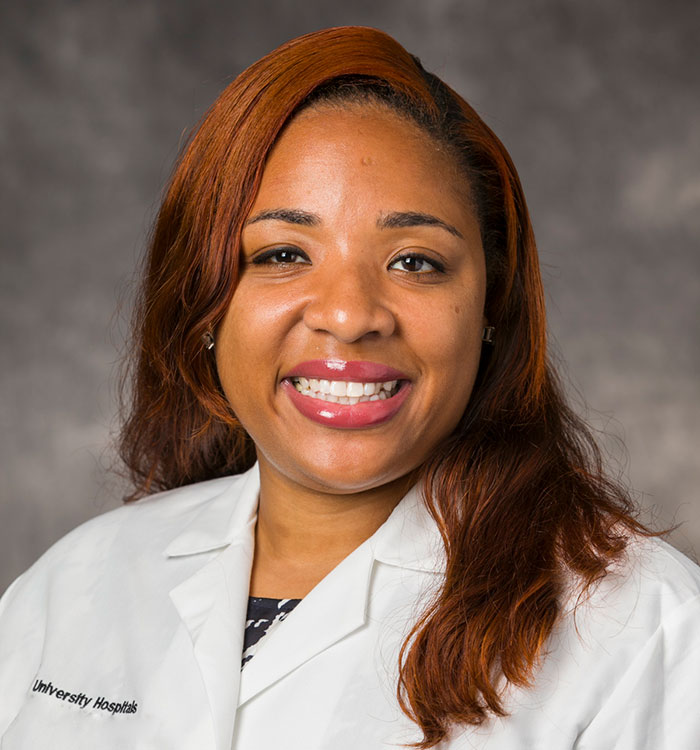Infant & Maternal Mortality: Improving Outcomes for Mothers and Infants
February 10, 2019
UH partners to tackle infant, maternal mortality in Cleveland
Innovations in Obstetrics & Gynecology – Winter 2019
Preterm birth, any birth before 37 weeks, is a significant risk factor for infant mortality, and Cleveland has one of the highest rates of preterm birth in the country, according to March of Dimes’ annual data. University Hospitals (UH) is leading collaborative efforts to make measurable change in both infant and maternal mortality.
 Da’Na Langford, CNM
Da’Na Langford, CNMCenteringPregnancy
In 2010, UH adopted a group prenatal care model from the Boston-based Centering Healthcare Institute to help address the needs of pregnant women in Cleveland. CenteringPregnancy is an evidence-based program designed to educate expectant mothers and provide a network of support. CenteringPregnancy has been shown to reduce preterm birth and low birthweight.
“A lot of our patients do not have a support system,” says Da’Na Langford, CNM, Chair of the MacDonald Women’s Hospital Maternal and Infant Mortality Committee, UH Cleveland Medical Center, and Clinical Instructor in the Division of Nurse-Midwifery, Department of Reproductive Biology at Case Western Reserve University School of Medicine. “CenteringPregnancy gives them a support system with a provider, and other women having the same experience.”
The CenteringPregnancy program brings together eight to 12 women with similar due dates. During two-hour sessions, the women are individually seen by a provider. Then, they gather together with two facilitators to learn about a variety of topics, including labor & birth, newborn care, managing stress, and domestic violence.
“The women in this program bond with one another,” Langford says. “They give each other rides. They go to each other’s baby showers. This support system helps relieve a small amount of the toxic stress that can lead to premature birth.”
The UH Centering program – named the Centering Healthcare Institute’s Regional Leadership Partner in the Midwest in early 2018 – has achieved positive results. Since 2010, the program has enrolled a total of 2,243 women and an overall preterm birth rate of 7.3 percent (2010-2018). In 2018, the program’s preterm birth rate was just 5.1 percent, compared with Cleveland’s overall rate of 14.4 percent (according to March of Dimes).
First Year Cleveland
UH is also an active stakeholder in First Year Cleveland, a collaboration of Cleveland-area health organizations, government leaders, local advocates and others dedicated to reducing the city’s infant mortality rate to less than 6.0 deaths per 1,000 live births by 2020.
To achieve its goal, First Year Cleveland has a unified strategy centered on reducing racial disparities, addressing extreme prematurity and eliminating sleep-related infant deaths.
National research from the Healthcare Cost and Utilization Project indicates that the rate of severe maternal morbidity – life-threatening conditions for mothers during delivery – is 112-115 percent higher for black women than for white women.
“Black women are more likely to die from childbirth and complications related to pregnancy,” Langford says. “We need to recognize that this problem is related to structural and institutional racism. We have to name the problem as a community, look at our own biases, and do something to make real change to save babies and mothers.”
Co-chaired by Patricia DePompei, President of UH Rainbow Babies & Children’s and MacDonald Women’s hospitals, First Year Cleveland is helping to make that change with support from organizations like UH. Participating organizations are working together on racial bias training, focus groups to better understand patient experience in the hospital, and increasing use of CenteringPregnancy group prenatal care and research to improve preterm birth and infant mortality rates.
“First Year Cleveland has eleven action teams of people from all over the community working to make change,” Langford says.
Uh Rainbow Center for Women &Amp; Children
The UH Rainbow Center for Women & Children is central to the health system’s efforts to bring the necessary care to mothers and children in the community.
“Rainbow Center is a wrap-around care center, which allows women and children in the community to get all of the health services they need under one roof,” Langford explains. Services offered at the center include vision, dentistry, women’s health, mental health, pediatrics, genetics, nutrition, ultrasound, social work, legal aid and more.
Women and children can come to the center to receive all of the care they need in a single day, if needed, Langford says. If women do not have anyone to watch their children while receiving their care, they can bring them to the Star Room, an area that provides supervised care and education for children while they wait for their mothers.
“UH is committed to expanding out into the community,” she says. “All of these programs show the community we stand with them, and we will tackle this health crisis together.”
For more information contact ObGynInnovations@UHhospitals.org.


